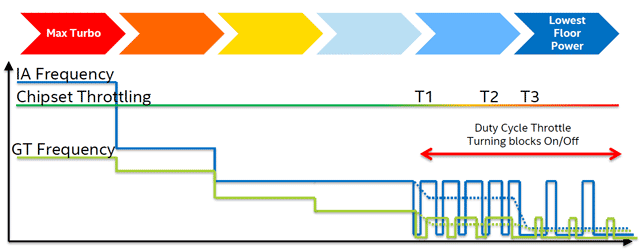What can we expect from 14 nanometers?

What Intel was talking about for so long, finally happened - the new generation Broadwell processors made on 14 nm technology are entering the market. In the near future we will see the first real devices based on Broadwell, but for now we have the opportunity, based on reliable first-hand information, to comprehensively examine the question: what will these notorious 14 nanometers bring to us?
As most people probably know even without CDRV, Broadwell is a tick-step in the Intel process, which by definition does not imply a revolutionary change in functionality. Nevertheless, naturally, there were some improvements and innovations, and this time there are probably more of them than in previous Tiki.
The first commercial product made on the new process technology, will be the processor Core M, designed for mobile and portable devices. This segment of the market was waiting for 14 nm especially impatiently, because the reduction of the process technology is, above all, a reduction in size and TDP. Premonitions did not deceive them: the new Core M allows passive cooling, and the thickness of the device cases can be no more than 9 mm.

Compared to 22 nm, the distance between dielectric fins in the 14-nm technology is reduced, the height of the barriers is increased, and their number is reduced. Original
')
Some more technical details. Core M uses the second generation of three-dimensional Tri-gate transistors. Due to technological improvements in them and the overall reduction in the size of the crystal area compared to Haswell decreased by more than 30%, while the number of transistors increased from 1 to 1.3 billion. The increase in performance was achieved due to the expansion of the associative broadcast buffer more accurate predictions of branching, as well as optimization of the operations of multiplication and division with floating point. But the greatest successes, as already mentioned, were achieved on the fronts of the struggle for non-consumed watts: Broadwell managed to twice exceed the energy saving indicators that were traditional when changing the process technology. Also, consumption has decreased by half compared to Haswell in absolute terms.

The power schemes of the processor, graphics core and chipset are becoming more intelligent. Starting with Broadwell, they use heuristic algorithms.
Energy efficiency is guarded by advanced power management technologies. This is, first of all, the new integrated voltage regulator (FIVR) of the second generation, which is faster and smarter transfer of the core from the standby state to the operating mode. In addition, the downtime voltage was reduced, as well as improved control over the power consumption of the entire chip as a whole, including memory controllers and peripherals.
Briefly mention the new functionality - maybe for someone they will be important:
- Improved cryptographic support. New instructions ADCX / ADOX and RDSEED (non-deterministic random numbers), hardware support for CRC and RSA.
- Intel trace system. Support for low-cost processor-level tracing that debugging software will use.
- Intel Transactional Synchronization Extensions (Intel TSX) - new advanced instructions to facilitate the work of multi-threaded applications.
- Improved virtualization. The VT-x technology, familiar to everyone, works faster and faster with each new generation.
Significant changes have occurred in the graphics core of the processor. The fundamentally new Intel HD Graphics 5300 graphics core supports DirectX 11.2, OpenGL API 4.3, OpenCL API 2.0, and 4K resolution screens. Improved tessellation mechanisms, increased the number of actuators in the core. According to the company, the performance gain in the graphics subsystem is about 40% in games and up to 80% when encoding video. To the already available support for decoding formats AVC, VC-1, MPEG2, MVC added video codec VP8, as well as decoding JPEG & MJPEG.

The processor core is core M. More than half the area is occupied by the graphics core. Original
Physically, the Core M is made in the form of two chips: in fact, a processor (which also has a graphics core and a memory controller) and the Platform Controller Hub (PCH) chipset, which in the old way is sometimes still called the south bridge. The chipset, in addition to solving traditional problems of organizing various I / O operations, now includes a Wi-Fi controller and an audio codec. Thus, Intel Core in its mobile incarnation is more and more approaching the SoC constructive, and there is no doubt that it will soon come closer at all. In the meantime, it's still a two-chip system.
The first models with an Intel Core M processor will appear on the shelves at the end of this - the beginning of next year. Well, we will wait for the next coming of 14 nanometers in the face of processors for the PC - surely there will be a lot of interesting things.
Source: https://habr.com/ru/post/238797/
All Articles